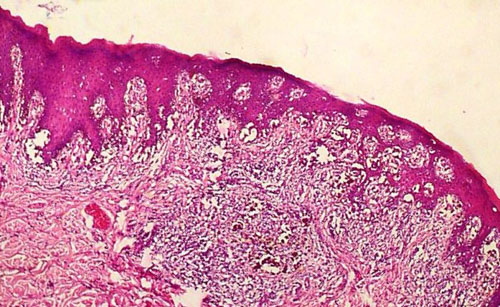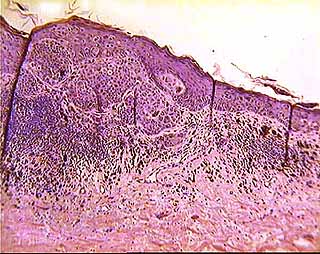The histopathology of melanoma is a complex field concerned with the study of cellular and tissue changes associated with the disease.
 |
 |
In superficial spreading melanoma, both nests of cancer cells and isolated cells are observed to begin to invade the epidermis and superficial dermis. During the vertical phase, cancer cells begin to invade the deeper layers of the skin. The skin in these areas may have acanthosis, with cells that appear large, have abundant cytoplasm, and a variable number of mitoses. A lymphocytic infiltrate may also be present, a sign of an immune response to tumor invasion.
In nodular melanoma, the tumor cells appear bulky, with large cytoplasm, or they may take on a spindle-shaped or epithelioid appearance. These cells are found distributed in the dermis and subcutis, and also in this case there is a significant lymphocyte response.
In acral lentiginous melanoma, dendritic melanocytes are present in large numbers in the basal epidermis and subsequently infiltrate the dermo-epidermal junction and the dermis.
Lentigo maligna melanoma is characterized by the proliferation of tumor cells in the basal layer and superficial dermal layers. In this case, the epidermis is thinned and solar elastosis is observed, i.e. a degeneration of the dermal tissue due to prolonged exposure to the sun. An infiltrate composed of histiocytes and plasma cells is also present.
Immunohistochemistry is a method used to identify specific proteins in cancer cells. S100, HMB-45, Mart 1, and MITF (microphthalmia transcription factor) are all markers used to identify and classify melanomas. However, not all markers are expressed in every type of melanoma, so their detection may provide additional information about the nature of the tumor.
In terms of advanced diagnostics, a new method for diagnosing melanoma known as fluorescence in situ testing (FISH) has been developed. This test can help identify chromosomal abnormalities that are not easily detected by standard cytogenetic methods. The test is based on cytogenetic techniques, DNA hybridization and fluorescence microscopy. This advanced methodology, available through laboratories such as Neogenomics and Abbott, is opening up new possibilities for the early diagnosis and personalized management of melanoma.